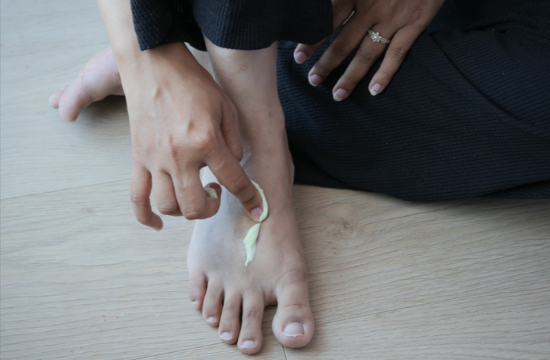Neosporin for Toenail Fungus: Safe and Reliable Option?
Contents

Toenail fungus is a common and persistent issue that many people face. It can cause discomfort, embarrassment, and even pain if left untreated.
While there are several over-the-counter treatments and home remedies available, one product that often gets mentioned is Neosporin.
You might have used Neosporin for cuts, scrapes, and minor skin infections, but can it work for toenail fungus too?
In this post, we’ll dive into whether Neosporin is effective for treating toenail fungus, how to use it, and what other treatments might be worth considering.
What is Toenail Fungus?
Toenail fungus, also known as onychomycosis, is a fungal infection that affects the toenails, causing them to become discolored, thickened, brittle, or even misshapen.
The infection can be unsightly and difficult to get rid of, often thriving in warm, moist environments.
Toenail fungus typically occurs when the fungi enter the nail through a small crack or injury. It’s more common in people who wear tight shoes, walk barefoot in damp public areas, or have weakened immune systems.
What is Neosporin?
Neosporin is an over-the-counter antibiotic ointment commonly used to treat minor cuts, scrapes, and burns. It contains three active ingredients: neomycin, polymyxin B, and bacitracin.
These ingredients work together to prevent bacterial infections by killing or inhibiting the growth of bacteria.
Neosporin is most effective for treating bacterial infections and is widely used for surface wounds. However, toenail fungus is caused by a fungus, not bacteria, so can Neosporin help?
Neosporin and Toenail Fungus: Does It Work?
Although Neosporin is an excellent treatment for bacterial infections, it’s not specifically designed to fight fungal infections like toenail fungus.
Fungus and bacteria are different types of pathogens, and they require different treatments.
Prevents Secondary Bacterial Infections
- While Neosporin doesn’t directly treat the fungus, it can help prevent secondary bacterial infections that might develop as a result of toenail fungus.
- When toenail fungus causes the nail to crack, split, or become inflamed, there’s a risk of bacterial infection. Neosporin can help protect the damaged area from bacterial contamination.
Supports Healing
- If your toenail fungus has caused any minor cuts or injuries to the skin around your nail, Neosporin could help those areas heal faster.
- By promoting faster skin regeneration, it might help reduce the risk of further infection and support the overall healing process.
However, if you’re looking to directly target the fungus itself, Neosporin is not the most effective treatment.
How to Use Neosporin for Toenail Fungus (If You Choose to Try It)?
If you decide to use Neosporin in conjunction with a proper antifungal treatment for toenail fungus,
here’s how you can use it
- Clean the Affected Area: Before applying any treatment, make sure your feet are clean and dry. Wash the affected toenail with mild soap and warm water, then dry thoroughly to prevent further fungal growth.
- Apply Antifungal Treatment First: For the best results, apply an antifungal treatment that’s specifically formulated for toenail fungus, such as clotrimazole, terbinafine, or tolnaftate. These treatments are designed to penetrate the nail and fight the fungal infection directly.
- Apply Neosporin: After applying the antifungal treatment, you can apply a thin layer of Neosporin around the infected toenail, especially if there are any cuts or cracks in the skin. This will help prevent any secondary bacterial infections and support healing.
- Cover the Toenail: If desired, cover the toenail with a clean bandage to keep the area protected from dirt and bacteria.
- Repeat Daily: Continue applying the antifungal treatment daily as instructed on the packaging. You can apply Neosporin once or twice a day to the skin around the nail if needed.
Other Effective Treatments for Toenail Fungus
While Neosporin can help with secondary infections, it’s not the best solution for treating toenail fungus directly. If you’re dealing with toenail fungus, here are some more effective treatment options:
1. Over-the-Counter Antifungal Creams
- Topical antifungal creams such as Lamisil or Lotrimin can be applied directly to the infected nail. These creams penetrate the nail and fight the fungus. It may take weeks to see results, so consistency is key.
2. Antifungal Nail Lacquers
- For more persistent cases, antifungal nail lacquers like Ciclopirox or Penlac can be applied directly to the nail. These lacquers are designed to treat toenail fungus and can be used under nail polish for cosmetic purposes.
3. Oral Antifungal Medications
- If the infection is severe, your doctor may prescribe oral antifungal medications such as Terbinafine or Itraconazole. These medications work from the inside out and are typically used for more extensive fungal infections that haven’t responded to topical treatments.
4. Home Remedies
- Some people have found success with home remedies like tea tree oil, oregano oil, or apple cider vinegar. These natural substances have antifungal properties that can help treat overall toenail fungus, though scientific evidence on their effectiveness is limited.
5. Laser Treatment
- In some cases, laser therapy may be an option. Laser treatment is designed to target and destroy the fungus in the nail. It’s typically used when other treatments have failed.
Preventing Toenail Fungus
Prevention is always better than cure. To reduce your risk of developing toenail fungus, consider these tips:
- Keep Feet Dry: Fungi thrive in warm, moist environments, so make sure your feet stay dry. After showering, thoroughly dry your feet, especially between your toes.
- Wear Breathable Shoes: Choose shoes made from breathable materials like leather or mesh to help keep your feet dry.
- Change Socks Regularly: If your feet tend to sweat, change your socks throughout the day to keep them dry and reduce fungal growth.
- Avoid Walking Barefoot in Public Areas: Fungi can spread easily in places like gym locker rooms, swimming pools, and public showers. Always wear flip-flops or sandals in these areas.
Final Thoughts
While Neosporin is an excellent antibiotic ointment for treating cuts and scrapes, it is not designed to treat toenail fungus.
The active ingredients in Neosporin target bacteria, not the fungus causing the infection. However, if you’re dealing with a fungal infection that has caused secondary bacterial issues, Neosporin can be a helpful addition to your treatment plan.
For best results in treating toenail fungus, stick with antifungal treatments specifically designed for the infection. Consult with a healthcare provider if your condition doesn’t improve or worsens over time.
Have you used Neosporin or other treatments for toenail fungus? Share your experience in the comments below!



